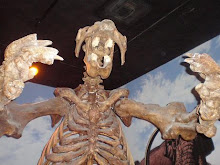 This is a photo of the Loxahatchee River, in the Florida Everglades, taken by Clyde Butcher, and found at this website.
This is a photo of the Loxahatchee River, in the Florida Everglades, taken by Clyde Butcher, and found at this website."Image of an 'ambassador for environment'" was an excellent article that I found at http://www.news-press.com/apps/pbcs.dll/article?AID=2009911270398. It ties in directly with everything that we have been going over in the University Colloquium class and I am very glad to have read it.
The story centers around Clyde Butcher, a photographer, whose works were actually being displayed at the Southwest Florida Historical Museum when my class visited. Earlier this month he installed a solar heating system for his home and his Big Cypress Gallery in Ochopee. "It's affordable, he says. It cost $34,000 to install the system at his home, but federal and state incentives plus tax credits will mean his eventual out-of-pocket cost will be less than $1,500." This quote from the article really surprised me! I never even considered all of the tax benefits, though I have heard from another source during the course of the class, that a person could actually sell their energy to the energy companies! My parents really need to get solar power pronto, if you ask me! I'm at least going to research it.
But his solar system setup was not the only sustainable bit of information from this writing. Butcher says that "there will be no everglades to save," if global warming keeps up. Another gentleman by the name of Frank Jackalone, is the Florida staff director of the Sierra Club, he added to Butcher's remarks that, "Clyde lives in ground zero. His home will disappear if we don't do something about global warming in the next 10 years." Figures are also given, such as the sea level rising six and half feet by 2100, and also that actions to curb warming must be put into effect by 2015. This is exactly what the author of my State of the World chapter was saying. The upcoming (December 7-18) United Nations climate summit was also noted.
Butcher's activism was apparently inspired by the film "An Inconvenient Truth." I will definitely have to watch that some time soon.
Here are some other quotes of interest:
"Rodney Barreto, chairman of the Florida Fish and Wildlife Conservation Commission, called Butcher 'an iconic ambassador for the environment.' The focus on global warming was a 'natural offshoot' of his Everglades activism, he said."
"The Everglades multi-billion dollar restoration effort flows naturally into the issue of global warming, Kimball said. It is more than just getting the water quality right, getting rid of exotic species, the recovery of endangered species and increasing water supply."
"'We think if we restore the Everglades, we can get more water going from north to south and a healthier landscape more resilient to the effects of climate change,' he said. It also will provide a bigger store of water to keep saltwater at bay."
Could I have found a more perfect article for this blog? Great stuff. In addition to getting solar power, I will have to check out Butcher's gallery some day too. He sounds like an important environmental figure.

















 We left the museum and were now loose in Downtown Ft. Myers. We saw parks that showcased various palm tree species from around the world, which I had no idea even existed.
We left the museum and were now loose in Downtown Ft. Myers. We saw parks that showcased various palm tree species from around the world, which I had no idea even existed.




